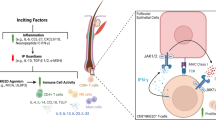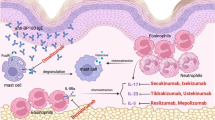Abstract
Background
Evaluation of the efficacy of molecular treatment strategies for lymphatic vascular insufficiency requires a suitable preclinical animal model. Ideally, the model should closely replicate the untreated human disease in its pathogenesis and pathological expression.
Objective
We have undertaken a study of the time course of the development and resolution of acquired, experimental lymphedema and of its responses to vascular endothelial growth factor (VEGF)-C lymphangiogenesis in the mouse tail model.
Study design
We provoked post-surgical lymphedema in the mouse tail model and assessed the effects of exogenously administered human recombinant VEGF-C. Quantitative assessment of immune traffic function was performed through sequential in vivo bioluminescent imaging.
Results
In untreated lymphedema, tail edema was sustained until day 21. Exogenous administration of human recombinant VEGF-C produced a significant decrease in volume. Untreated lymphedema in the mouse tail model was characterized by the presence of dilated cutaneous lymphatics, marked acute inflammatory changes, and hypercellularity; VEGF-C produced a substantial reversion to the normal pattern, with notable regression in the size and number of cutaneous lymphatic vessels that express lymphatic vessel endothelial hyaluronan receptor-1 (LYVE-1). In vivo imaging confirmed the presence of an impairment of immune traffic in lymphedema that was ameliorated after VEGF-C administration.
Conclusion
The post-surgical murine tail model of lymphedema closely simulates attributes of human lymphedema and provides the requisite sensitivity to detect therapeutically induced functional and structural alterations. It can, therefore, be used as an investigative platform to assess mechanisms of disease and its responses to candidate therapies, such as therapeutic lymphangiogenesis.





Similar content being viewed by others
References
Schmid-Schonbein GW. Microlymphatics and lymph flow. Physiol Rev 1990; 70(4): 987–1028
Swartz MA. The physiology of the lymphatic system. Adv Drag Deliv Rev 2001; 50(1–2): 3–20
Szuba A, Rockson SG. Lymphedema: classification, diagnosis and therapy. Vasc Med 1998; 3(2): 145–56
Rockson SG. Lymphedema. Am J Med 2001; 110(4): 288–95
Piller NB. Macrophage and tissue changes in the developmental phases of secondary lymphoedema and during conservative therapy with benzopyrone. Arch Histol Cytol 1990; 53: 209–18
Daroczy J. Pathology of lymphedema. Clin Dermatol 1995; 13(5): 433–44
Rockson SG, Miller LT, Senie R, et al. American Cancer Society Lymphedema Workshop: workgroup III. Diagnosis and management of lymphedema. Cancer 1998; 83(12 Suppl. American): 2882–5
Ferrara N, Alitalo K. Clinical applications of angiogenic growth factors and their inhibitors. Nat Med 1999; 5: 1359–64
Alitalo K, Carmeliet P. Molecular mechanisms of lymphangiogenesis in health and disease. Cancer Cell 2002; 1(3): 219–27
An A, Rockson SG. The potential for molecular treatment strategies in lymphatic disease. Lymphat Res Biol 2004; 2(4): 173–81
Szuba A, Skobe M, Karkkainen MJ, et al. Therapeutic lymphangiogenesis with human recombinant VEGF-C. FASEB J 2002; 16(14): 1985–7
Yoon YS, Murayama T, Gravereaux E, et al. VEGF-C gene therapy augments postnatal lymphangiogenesis and ameliorates secondary lymphedema. J Clin Invest 2003; 111(5): 717–25
Swartz MA, Berk DA, Jain RK. Transport in lymphatic capillaries: I. Macroscopic measurements using residence time distribution theory. Am J Physiol 1996; 270 (1 Pt 2): H324–9
Swartz MA, Boardman Jr KC. The role of interstitial stress in lymphatic function and lymphangiogenesis. Ann N Y Acad Sci 2002; 979: 197–210, discussion 134
Slavin SA, Van den Abbeele AD, Losken A, et al. return of lymphatic function after flap transfer for acute lymphedema. Ann Surg 1999; 229 (3): 421-7
Boardman KC, Swartz MA. Interstitial flow as a guide for lymphangiogenesis. Circ Res 2003; 92(7): 801–8
Swartz MA, Kaipainen A, Netti PA, et al. Mechanics of interstitial-lymphatic fluid transport: theoretical foundation and experimental validation. J Biomech 1999; 32(12): 1297–307
Jeltsch M, Kaipainen A, Joukov V, et al. Hyperplasia of lymphatic vessels in VEGF-C transgenic mice. Science 1997; 276(5317): 1423–5
Casley-Smith JR, Clodius L, Foldi M. Experimental blood vascular and lymphatic occlusion in the rabbit ear and the effect of benzopyrones. Arzneimittelforschung 1977; 27(2): 379–82
Slavin SA, Upton J, Kaplan WD, et al. An investigation of lymphatic function following free-tissue transfer. Plast Reconstr Surg 1997; 99(3): 730–41, discussion 742-3
Joukov V, Pajusola K, Kaipainen A, et al. A novel vascular endothelial growth factor, VEGF-C, is a ligand for the Flt4 (VEGFR-3) and KDR (VEGFR-2) receptor tyrosine kinases. EMBO J 1996; 15: 290–8
Sitzia J. Volume measurement in lymphoedema treatment: examination of formulae. Eur J Cancer Care (Engl) 1995; 4(1): 11–6
Cao YA, Wagers AJ, Beilhack A, et al. Shifting foci of hematopoiesis during reconstitution from single stem cells. Proc Natl Acad Sci U S A 2004; 101(1): 221–6
Beilhack A, Schulz S, Baker J, et al. In vivo analyses of early events in acute graft-versus-host disease reveal sequential infiltration of T cell subsets. Blood 2005 Aug 1; 106(3): 1113–22
Banerji S, Ni J, Wang SX, et al. LYVE-1, a new homologue of the CD44 glycoprotein, is a lymph-specific receptor for hyaluronan. J Cell Biol 1999; 144(4): 789–801
Jackson DG. Biology of the lymphatic marker LYVE-1 and applications in research into lymphatic trafficking and lymphangiogenesis. Apmis 2004; 112(7–8): 526–38
Yong C, Bridenbaugh EA, Zawieja DC, et al. Microarray analysis of VEGF-C responsive genes in human lymphatic endothelial cells. Lymphat Res Biol 2005; 3(4): 183–207
Hong YK, Shin JW, Detmar M. Development of the lymphatic vascular system: a mystery unravels. Dev Dyn 2004; 231(3): 462–73
Tammela T, Enholm B, Alitalo K, et al. The biology of vascular endothelial growth factors. Cardiovasc Res 2005; 65(3): 550–63
Shin WS, Szuba A, Rockson SG. Animal models for the study of lymphatic insufficiency. Lymphat Res Biol 2003; 1(2): 159–69
Enholm B, Karpanen T, Jeltsch M, et al. Adenoviral expression of vascular endothelial growth factor-C induces lymphangiogenesis in the skin. Circ Res 2001; 88(6): 623–9
Saaristo A, Veikkola T, Enholm B, et al. Adenoviral VEGF-C overexpression induces blood vessel enlargement, tortuosity, and leakiness but no sprouting angiogenesis in the skin or mucous membranes. Faseb J 2002; 16(9): 1041–9
Goldman J, Le TX, Skobe M, et al. Overexpression of VEGF-C causes transient lymphatic hyperplasia but not increased lymphangiogenesis in regenerating skin. Circ Res 2005; 96(11): 1193–9
Wilson SF. Histopathologic improvement with lymphedema management, Leogane, Haiti. Emerg Infect Dis 2004; 10(11): 1938–46
Makinen T, Jussila L, Veikkola T, et al. Inhibition of lymphangiogenesis with resulting lymphedema in transgenic mice expressing soluble VEGF receptor-3. Nat Med 2001; 7(2): 199–205
Karkkainen MJ, Saaristo A, Jussila L, et al. A model for gene therapy of human hereditary lymphedema. Proc Natl Acad Sci U S A 2001; 98(22): 12677–82
Schneider M, Ny A, de Almodovar CR, et al. A new mouse model to study acquired lymphedema. PLoS Med 2006; 3(7): e264
Tabibiazar R, Cheung L, Han J, et al. Inflammatory manifestations of experimental lymphatic insufficiency. PLoS Med 2006; 3(7): e254
Acknowledgments
The authors gratefully acknowledge grant support from the Western States Affiliate of the American Heart Association (grant no. 0355120Y).
The sponsor had no role in the design of the study, performance of the research, or writing of the manuscript.
The authors have no conflicts of interest that are directly relevant to the content of this study.
Author information
Authors and Affiliations
Corresponding author
Rights and permissions
About this article
Cite this article
Cheung, L., Han, J., Beilhack, A. et al. An Experimental Model for the Study of Lymphedema and its Response to Therapeutic Lymphangiogenesis. BioDrugs 20, 363–370 (2006). https://doi.org/10.2165/00063030-200620060-00007
Published:
Issue Date:
DOI: https://doi.org/10.2165/00063030-200620060-00007




